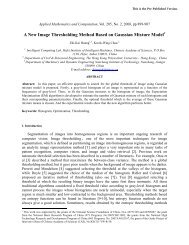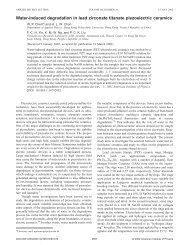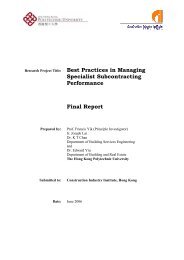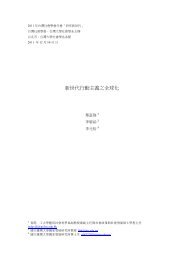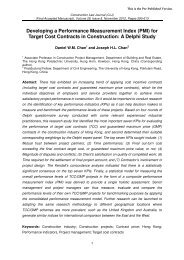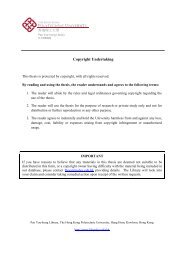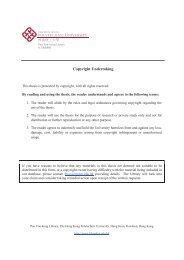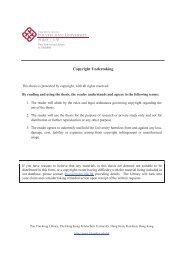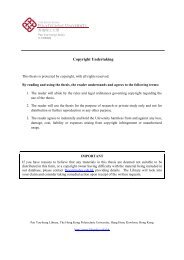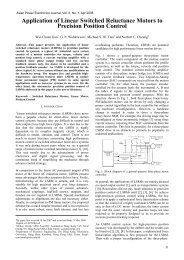Research Article Ginseng Extracts Restore High-Glucose Induced ...
Research Article Ginseng Extracts Restore High-Glucose Induced ...
Research Article Ginseng Extracts Restore High-Glucose Induced ...
Create successful ePaper yourself
Turn your PDF publications into a flip-book with our unique Google optimized e-Paper software.
4 Evidence-Based Complementary and Alternative Medicine<br />
Table 1: Contents of ginsenosides in the prepared PPT-type and PPD-type ginsenosides.<br />
Sample Ginsenosides Content (mg/g) Percentage<br />
Rg1 290.9 29.09%<br />
PPT-type ginsenosides<br />
Re 339.6 33.96%<br />
Rb1 246.3 24.63%<br />
Rc 231.30 23.13%<br />
PPD-type ginsenosides<br />
Rb2 136.0 13.61%<br />
Rd 84.5 8.45%<br />
web-based software package for the PCR Array System,<br />
which automatically performs all ΔΔCt based fold-change<br />
calculations from raw threshold cycle data.<br />
2.6. Statistical Analysis. All values are expressed as mean ±<br />
standarderrorofmean(SEM).Thesignificantdifferences<br />
between the young and aged groups in the isolated tissue<br />
experiments were analyzed using one way ANOVA with<br />
Newman-Keuls multiple comparison as post hoc test in the<br />
statistical package (Graphpad prism v6.0). A P value less<br />
than 0.05 was considered to be significant. The mean values<br />
were obtained from at least 5 animals or 3 DNA samples per<br />
treatment group.<br />
3. Results<br />
3.1. <strong>Ginseng</strong> <strong>Extracts</strong> <strong>Restore</strong> <strong>High</strong> <strong>Glucose</strong>-<strong>Induced</strong> Endothelial<br />
Dysfunction. Acetylcholine (ACh) causes vasodilation<br />
by activation of endothelial nitric oxide synthase and<br />
prostaglandin production. The aortic tissue was challenged<br />
with acetylcholine (1 × 10 −9 M–1 × 10 −5 M) and caused<br />
concentration-dependent relaxations in aortic rings from<br />
young rats. Normal rats showed 100% relaxation (restored<br />
the contracting state to resting state) at maximum dose 1×<br />
10 −5 M, while the response was only 62.5% of the relaxation<br />
in the diabetic rats (Figure 2(a)), showing an impairment<br />
of the endothelium. For positive control, diabetic rats were<br />
injected with insulin and the normal vasorelaxation was<br />
maintained (Figure 2(b)). After feeding PPD-type and PPTtype<br />
ginseng extracts for two weeks, the impaired vasorelaxationduetohighglucoselevelwasrestored(Figures<br />
2(c) to 2(f)), indicating that the endothelial functions were<br />
maintained under the diabetic conditions for the ginseng-fed<br />
groups.<br />
3.2. Blood Profile, Body Weight, Distribution of Visceral Adipose<br />
Tissue, and Organs Weight of the Experimental Rats. In<br />
this study, blood glucose, insulin, advanced glycation end<br />
products, serum total cholesterol, high density lipoprotein<br />
(HDL), low density lipoprotein (LDL), and triglyceride were<br />
examined. Except for normal and insulin injected positive<br />
control group, all of the diabetic groups were considered<br />
to be diabetic (blood glucose >16.7 mmol/dL) and with a<br />
significant reduction of insulin level (Figure 3(a)). There are<br />
no statistical differences between the ginseng-fed or nonfed<br />
diabetic groups for blood glucose, insulin, serum total cholesterol,<br />
HDL, and LDL (Figures 3 and 5(a)–5(c)), indicating<br />
the ginseng extracts have no improvement on hyperglycemic<br />
conditions or alternation of cholesterol levels. However, there<br />
is a slight decrease in the level of glycation end products<br />
(Figure 4), when the diabetic group was fed with PPT-type<br />
of ginseng at a dosage of 30 mg/kg/day. In addition, there<br />
was also significant decrease in serum triglyceride level for<br />
all ginseng-fed groups, which indicated that both PPD-type<br />
and PPT-type are effective in lowering serum triglyceride<br />
(Figure 5(d)). Visceral adipose tissue is associated with fatty<br />
acid metabolism. The distribution of visceral adipose tissue<br />
surrounding mesenteric arteries was shown in Figure 6.More<br />
visceraladiposetissuewasfoundincontrolgroupwhen<br />
comparedtothediabeticgroup.However,morevisceral<br />
adipose tissue was observed in diabetic rats after feeding with<br />
PPD-type and PPT-type of ginseng extracts. The body mass<br />
and organ mass are the health indicators for the experimental<br />
rats. Figure 7 showedthebodyandorganweightofthe<br />
experimental rats. The body weight of the insulin-injected<br />
diabetic groups is slightly larger than other groups. Among<br />
all organs measured (liver, pancreas, heart, adrenal gland, and<br />
kidneys), the PPD-type fed diabetic groups have significantly<br />
smaller adrenal glands than diabetic group (P < 0.05).<br />
3.3. <strong>Ginseng</strong> Extract Suppresses the Expression of Atherosclerosis-Related<br />
Genes. PCR array analysis showed the fold<br />
change of atherosclerosis-related gene expression (Figure 8<br />
and Table 2) for different treatment groups. When compared<br />
to normal control group, diabetic groups showed an upregulation<br />
on several atherosclerosis-related gene expressions,<br />
which indicate an increased risk of atherosclerosis. Besides,<br />
the gene expressions related to inflammations including<br />
adhesion molecules such as selectin (platelet) and ICAM1<br />
and macrophage activation including chemokine (C-C) motif<br />
ligand 2 (CCl-2), chemokine (C-X-C) motif ligand 1 (CxCl-<br />
1), interleukin 1 receptor 2 (IL1-R2), interleukins (IL3, IL4<br />
and IL5), and tumor necrosis factor-α (TNF-α) weredownregulated.<br />
Apart from genes related to inflammation, other<br />
genes involved in the development of atherosclerosis were<br />
also checked. Apoptotic genes, such as Bid as well as genes<br />
responsible for vascular endothelial cells and vascular smooth<br />
muscle cell proliferation and migration (including von Willebrand<br />
factor homolog, heparin-binding EGF-like growth<br />
factor, and thrombospondin 4), were also downregulated in<br />
ginseng-fed diabetic groups. On the other hand, lipid-related<br />
genes expression including apolipoprotein E (ApoE), lipase,<br />
and peroxisome proliferator-activated receptor (PPAR) γ<br />
were increased in the ginseng-fed groups.



